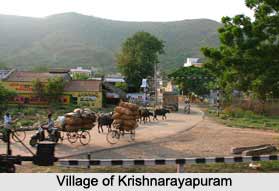 Location of Krishnarayapuram
Location of Krishnarayapuram
Krishnarayapuram is situated in the district of Karur of Tamil Nadu state of India. Krishnarayapuram has the Kaveri River flows through the region. Sometimes Krishanarayapuram can be spelt differently as Krishnarayapuram. Some people also prefer to identify Krishnarayapuram as Sithalavai.
Demography of Krishnarayapuram
The most prominent is the Census report that has been published in the year 2001. As per the demographic report, the total population of Krishnarayapuram showed a total population of 10,526. Quite interesting is the fact that in Krishnarayapuram both male and female populaces are in equal proportion. In other words, male populace constitutes 50 % of the population, while the population of females also is the same. In Krishnarayapuram town, 12 % of the total population is below six years of age.
Education of Krishnarayapuram
The average literacy rate of Krishnarayapuram constitutes 61 %. It is therefore higher than that of the entire nation, which constitutes 59.5 %. Male literacy is 68 %, which gives hint of males being inclined to education and learning. However female literacy is 54 %.
 Tourism of Krishnarayapuram
Tourism of Krishnarayapuram
The adjacent to Krishnarayapuram few places also have flourished. Thottiyam lies in the northeast and in the northwestern part Kattuputhur is located. Uppidamangalam and Mahadhanapuram are located in the southwest and in the east respectively. The primary attraction of the place is Maha Lakshmi Amman Temple. Raja Krishna Deva Raya constructed this temple. In fact the popular saying is that the name of `Krishanarayapuram` has been named after him. Apart from this temple, there are other places of interests, which have flourished in the neighborhood. These include Kalyana Venkattaramasami Temple at Thanthoni, Sri Jaya Anjaneya Swami Temple at Lalapet, Kadambavananathar Temple at Kulittalai and Shantivanam Church, Vennaimalai Subramanyar Temple.
Visiting Information
Krishnarayapuram is well connected via road, rails and also airports. Tiruchirapalli Airport lies in vicinity. From places like Karur and Kulittalai one can reach Krishanarayapuram via roadway.
Being an integral part of Karur district it is apparent that people of Krishnarayapuram too follow the same tradition as well. Similar to many places of India, here agriculture also is the main source of income. Moreover Sugar, Paper, Cement, Textile, Bus Body Building are the products that have also grown here.



















